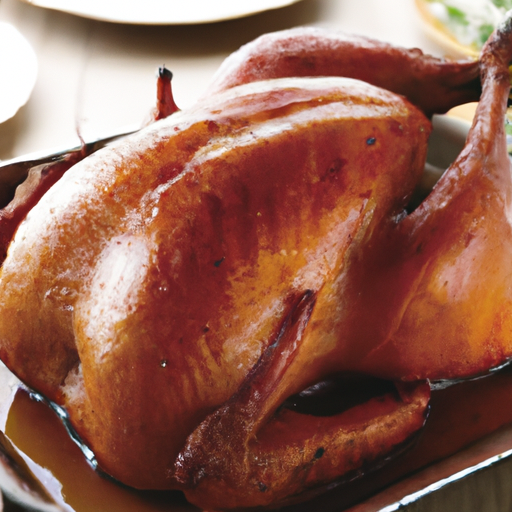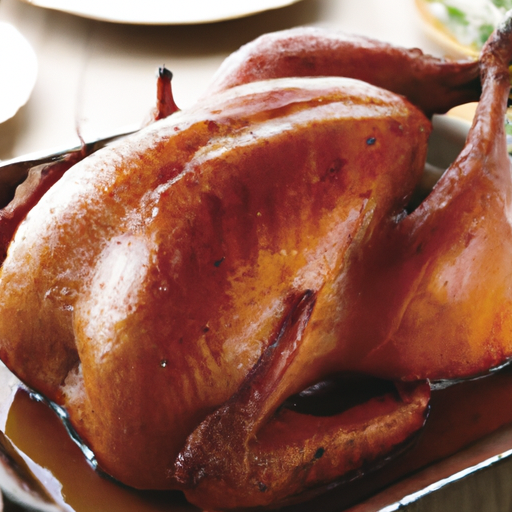Are you tired of serving dry and flavorless turkey every Thanksgiving? Look no further than “The Ultimate Turkey Cooking Guide”, your new go-to resource for achieving the perfect turkey every time. Packed with expert tips, step-by-step instructions, and a handy turkey cooking chart, this guide will have you cooking up moist and delicious turkeys that will impress your family and friends. Say goodbye to overcooked or undercooked birds and welcome a new era of turkey perfection with “The Ultimate Turkey Cooking Guide”.
Choosing the Right Turkey
When it comes to choosing the perfect turkey for your holiday feast, there are a few things to consider. One important decision to make is whether to go with a fresh or frozen turkey. Both options have their pros and cons. Fresh turkeys are often more expensive but can offer a superior flavor and texture. On the other hand, frozen turkeys are more readily available and can be stored for longer periods of time. Ultimately, the choice between fresh and frozen turkey comes down to personal preference and convenience.
Another important factor to consider is the size and weight of the turkey. The size of your gathering will determine the size of turkey you should buy. As a general guide, you’ll need about 1 to 1 ½ pounds of turkey per person. Keep in mind that larger turkeys will take longer to cook, so plan accordingly. Additionally, it’s important to choose a turkey that fits comfortably in your cooking equipment. Check the dimensions of your oven or roasting pan to ensure that the turkey you choose will fit properly.
Lastly, take some time to research different brands and types of turkey available in your area. Some brands may offer organic or free-range options, which can be important for those who prioritize ethical and sustainable farming practices. Consider reading reviews or asking for recommendations from friends or family who have previous experience with specific turkey brands. Ultimately, the goal is to choose a turkey that meets your preferences and aligns with your values.
Preparation and Thawing
Before you start cooking your turkey, proper preparation and thawing are essential steps to ensure a delicious and safe meal.
Thawing a turkey is a crucial step that requires careful planning. The safest way to thaw a turkey is in the refrigerator. Allow approximately 24 hours of thawing time for every 4-5 pounds of turkey. Place the turkey in a shallow pan or tray to catch any juice that may leak during the thawing process. It’s important to keep the turkey in its original packaging and never thaw it on the counter at room temperature, as this can allow harmful bacteria to multiply.
Once your turkey is thawed, it’s time to prep it for cooking. Start by removing the neck and giblets from the body cavity, which are often found in a bag inside the turkey. Rinse the turkey inside and out with cold water and pat it dry with paper towels. This step helps to remove any lingering ice crystals and ensures a clean surface for seasoning.
Cooking Methods
There are several different cooking methods you can use to cook your turkey, each with its own unique flavor and texture outcomes.
The most traditional method of cooking a turkey is roasting. This involves placing the turkey on a roasting rack in a roasting pan and cooking it in the oven at a specific temperature and time. Roasting allows for a crispy and golden skin and tender meat.
If you’re looking for a quicker cooking process and a turkey with crispy skin all over, deep-frying might be a great option for you. Deep-frying requires immersing the turkey in hot oil, resulting in a juicy and flavorful bird.
For those who love the smoky flavor, grilling a turkey can be a fantastic option. Grilling gives the turkey a unique flavor profile and can result in tender and moist meat. However, grilling a turkey requires careful monitoring of the temperature and flame control.
If you’re short on time or prefer a more even and quicker cooking process, spatchcocking is a method worth exploring. Spatchcocking involves removing the backbone of the turkey and flattening it out before cooking. This technique reduces cooking time and allows for more even cooking and crispy skin.
Lastly, smoking is a cooking method that infuses your turkey with a rich woody flavor. Smoking requires a longer cooking time but produces incredibly tender and flavorful meat.
Roasting Tips and Techniques
Roasting a turkey can seem intimidating, but with a few tips and techniques, you’ll be well on your way to a perfectly cooked bird.
To ensure even cooking, it’s helpful to tie the turkey. This involves using kitchen twine to secure the wings and legs against the turkey’s body. Tying the turkey helps to keep everything compact and promotes even cooking.
If you prefer to cook your stuffing inside the turkey, it’s important to follow some guidelines. Make sure the stuffing is prepared just before stuffing the bird and is not tightly packed. The stuffing should be loosely filled to allow for proper heat circulation and thorough cooking.
Using a roasting rack is also crucial in obtaining a nicely cooked turkey. A roasting rack elevates the turkey, allowing heat to circulate more evenly around the bird. This helps to prevent the bottom of the turkey from becoming soggy and promotes an even browning.
Basting and glazing the turkey during the cooking process can enhance its flavor and help to keep the meat moist. Basting involves periodically spooning the drippings or a mixture of melted butter and herbs over the turkey to add flavor and prevent it from drying out. Glazing, on the other hand, entails brushing a sweet or savory glaze onto the turkey during the last few minutes of cooking to create a glossy and flavorful finish.
Cooking Times and Temperatures
Cooking times and temperatures are crucial aspects of achieving a perfectly cooked turkey while ensuring food safety.
As a general guideline, roasting a turkey at 350°F for approximately 15 minutes per pound is a safe bet. However, it’s essential to use a meat thermometer to determine doneness accurately. The thickest part of the turkey’s thigh should reach an internal temperature of 165°F to ensure it’s fully cooked.
Using a meat thermometer is a foolproof way to know when your turkey is cooked to perfection. Insert the thermometer into the thickest part of the thigh, without touching the bone, and wait for the dial to give you an accurate reading. This will help you avoid overcooking or undercooking the turkey.
Calculating cooking times may also be necessary, especially if you’re using alternative cooking methods or have a larger or smaller turkey. Many cooking charts and websites offer detailed calculations based on the weight of the turkey and the chosen cooking method. Be sure to account for the resting time after cooking, as the turkey’s temperature will continue to rise even after it’s taken out of the oven.
Stuffing or Dressing
The decision whether to stuff the turkey or prepare the stuffing separately is a matter of personal preference and food safety.
If you choose to stuff the turkey, it’s essential to follow some safety guidelines. Stuff the turkey just before roasting, as prepared stuffing should not be left sitting inside the bird for an extended period. Make sure the stuffing is loosely filled inside the turkey to allow for thorough cooking.
For safety reasons, it’s advisable to cook stuffing separately in an oven dish. This method eliminates any concerns about the stuffing not reaching safe temperatures. Cooking the stuffing separately also allows for more control over its consistency and flavors. You can bake it alongside the turkey or prepare it beforehand and reheat it just before serving.
Safety Measures
Ensuring the safety of your turkey during the cooking process is of utmost importance to prevent foodborne illnesses.
When thawing a turkey, it’s crucial to follow proper safety measures. The refrigerator thawing method is the safest option, as it prevents the growth of harmful bacteria. Never leave the turkey out at room temperature to thaw, as this allows bacteria to multiply rapidly. If you’re in a time crunch, using the cold water thawing method is also safe and effective, as long as you change the water every 30 minutes.
Proper handling of the turkey throughout the cooking process is key to maintaining food safety. Thoroughly wash your hands, utensils, and surfaces before and after handling raw turkey to avoid cross-contamination. Keep raw turkey separate from other ingredients to prevent the spread of bacteria.
Cooking the turkey to the proper internal temperature is essential for its safety. Use a meat thermometer to ensure the thickest part of the turkey’s thigh reaches 165°F. This kills any harmful bacteria that may be present.
Carving and Serving
Once your turkey is cooked to perfection, it’s time to carve and serve it. Follow these simple techniques for a beautiful presentation.
To carve the turkey, start by removing the legs and wings. Cut the skin between the body and leg joint, then use a knife to separate the leg from the body. For the wings, again cut the skin at the joint and gently dislocate it to release the wing. Next, remove the breast meat by making a long cut along the breastbone. Slice the breast meat into thin, even slices for serving.
Plating and presentation are important aspects of serving a turkey that will wow your guests. Arrange the carved turkey on a serving platter, garnishing it with herbs, fruits, or other decorative elements. Surround the turkey with your favorite side dishes to create a visually appealing and inviting spread.
Leftovers and Storage
Turkey leftovers are a delicious bonus of any holiday feast, but proper storage and reheating are crucial to maintain food safety.
To store leftover turkey, remove all the meat from the bones and place it in airtight containers or wrap it tightly with plastic wrap. Refrigerate the leftovers promptly, ideally within two hours of cooking. Make sure to consume the leftovers within 4-5 days to ensure their freshness and taste.
When it comes to reheating leftover turkey, there are a few things to keep in mind. Avoid reheating the whole bird, as this can lead to dry and overcooked meat. Instead, slice or shred the turkey before reheating it. You can use the stovetop, microwave, or oven to warm up the turkey. Add a little bit of broth, gravy, or sauce to keep the meat moist and flavorful.
If you’re feeling creative, there are endless possibilities for using leftover turkey in delicious recipes. From turkey sandwiches and wraps to soups, salads, and casseroles, the possibilities are truly endless. Get creative in the kitchen and explore new ways to enjoy your leftover turkey.
Additional Tips and Tricks
To ensure a successful turkey cooking experience, here are some additional tips and tricks to consider.
Frequently asked questions (FAQs) can provide valuable insights and troubleshoot common concerns. Do some research or consult reputable sources to find answers to questions you may have about cooking turkey.
Perfecting the gravy is often a crucial component of serving a delicious turkey. Save the drippings from roasting and use them to make a rich and flavorful gravy. Experiment with different herbs and seasonings to customize the flavor to your liking.
If you’re looking for alternative turkey recipes, there are plenty of options to explore. From brining and herb-rubbed turkeys to stuffed turkey breast and turducken, there are countless variations to suit different tastes and preferences.
In conclusion, cooking the perfect turkey requires careful selection, thorough preparation, and proper cooking techniques. By following these tips and techniques, you’re well on your way to impressing your guests with a delicious and beautifully cooked turkey.

